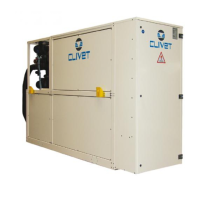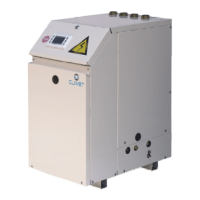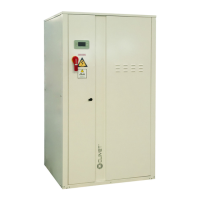Do you have a question about the CLIVET WSHN-XEE2 16.2 and is the answer not in the manual?
Discusses outdoor installation, system designer's role, and electrical compliance.
Advises immediate deactivation, contacting service, and using genuine spare parts.
Lists essential training topics for users by the installer, including operation and breakdown.
Provides steps for safe handling and lifting equipment, including verification and protection.
Lists criteria for selecting an installation site, including accessibility and safety.
Discusses water features, acceptable values, and consequences of poor quality.
Details steps for making hydraulic connections, including welding and unions.
Installer defines component type and position in the system for recommended connections.
Explains the flow switch's purpose for shutdown and installation guidelines.
Lists steps for the unit's operational sequence, including filling and testing.
Describes electrical data found on the serial number label and matriculation plate.
Step-by-step guide for making electrical connections, including isolation and earthing.
Illustrates customer wiring connections for various inputs and outputs.
Details PC connection, configuration steps, IP settings, and browser access.
Covers Modbus/RS485 communication option, cable requirements, and network setup.
States that start-up operations require qualified technicians and prior agreement.
Lists essential checks before unit power supply, covering safety and installation aspects.
Provides a detailed step-by-step procedure for unit start-up after power supply.
Outlines checks for the refrigeration circuit, including oil stains and pressure.
Details checks for the water circuit, ensuring it's filled, pressurized, and free of air.
Covers checks for the electric circuit, including grounding, conductor tightening, and voltage.
Explains the demand limit function for controlling absorbed electric power via an external signal.
Describes automatic set-point regulation based on outside temperature using defined curves.
Explains how water reset correction affects the setpoint based on climate curve TExt.
Outlines the procedure for adjusting the unit's setpoint values.
Details how to access alarm lists, identify causes, and reset alarms.
A comprehensive list of alarm codes, their descriptions, and associated faults.
Covers maintenance objectives, authorized personnel, and pre-check procedures.
Details recommended inspection intervals and items for periodic checks.
Describes the function, requirements, and operating conditions for Natural Cooling.
Covers general risks, electric parts, moving parts, refrigerant, and hydraulic parts.
Discusses outdoor installation, system designer's role, and electrical compliance.
Advises immediate deactivation, contacting service, and using genuine spare parts.
Lists essential training topics for users by the installer, including operation and breakdown.
Provides steps for safe handling and lifting equipment, including verification and protection.
Lists criteria for selecting an installation site, including accessibility and safety.
Discusses water features, acceptable values, and consequences of poor quality.
Details steps for making hydraulic connections, including welding and unions.
Installer defines component type and position in the system for recommended connections.
Explains the flow switch's purpose for shutdown and installation guidelines.
Lists steps for the unit's operational sequence, including filling and testing.
Describes electrical data found on the serial number label and matriculation plate.
Step-by-step guide for making electrical connections, including isolation and earthing.
Illustrates customer wiring connections for various inputs and outputs.
Details PC connection, configuration steps, IP settings, and browser access.
Covers Modbus/RS485 communication option, cable requirements, and network setup.
States that start-up operations require qualified technicians and prior agreement.
Lists essential checks before unit power supply, covering safety and installation aspects.
Provides a detailed step-by-step procedure for unit start-up after power supply.
Outlines checks for the refrigeration circuit, including oil stains and pressure.
Details checks for the water circuit, ensuring it's filled, pressurized, and free of air.
Covers checks for the electric circuit, including grounding, conductor tightening, and voltage.
Explains the demand limit function for controlling absorbed electric power via an external signal.
Describes automatic set-point regulation based on outside temperature using defined curves.
Explains how water reset correction affects the setpoint based on climate curve TExt.
Outlines the procedure for adjusting the unit's setpoint values.
Details how to access alarm lists, identify causes, and reset alarms.
A comprehensive list of alarm codes, their descriptions, and associated faults.
Covers maintenance objectives, authorized personnel, and pre-check procedures.
Details recommended inspection intervals and items for periodic checks.
Describes the function, requirements, and operating conditions for Natural Cooling.
Covers general risks, electric parts, moving parts, refrigerant, and hydraulic parts.











